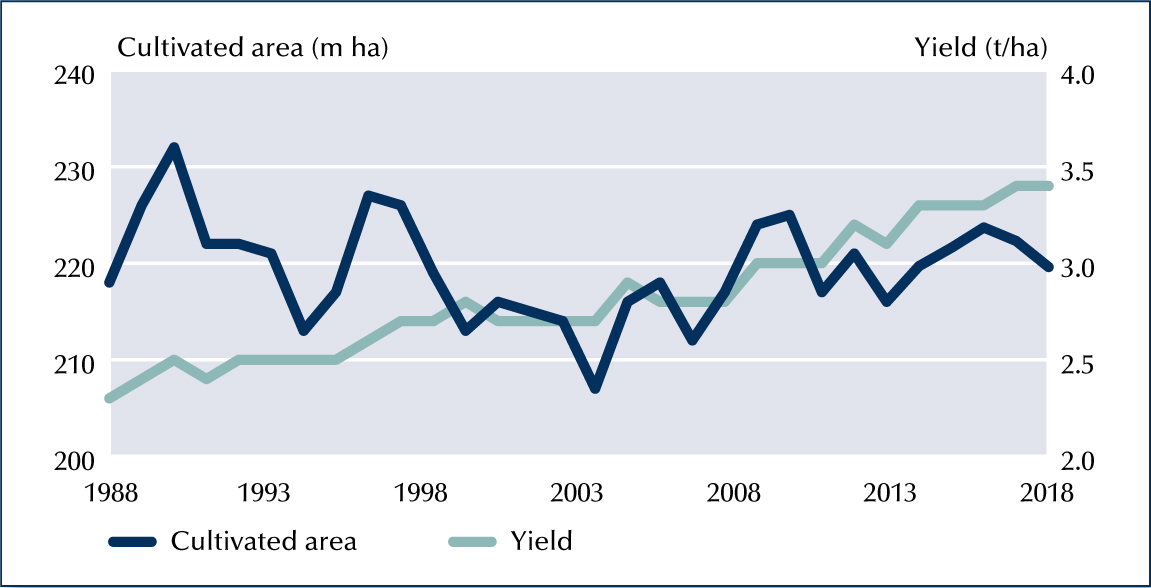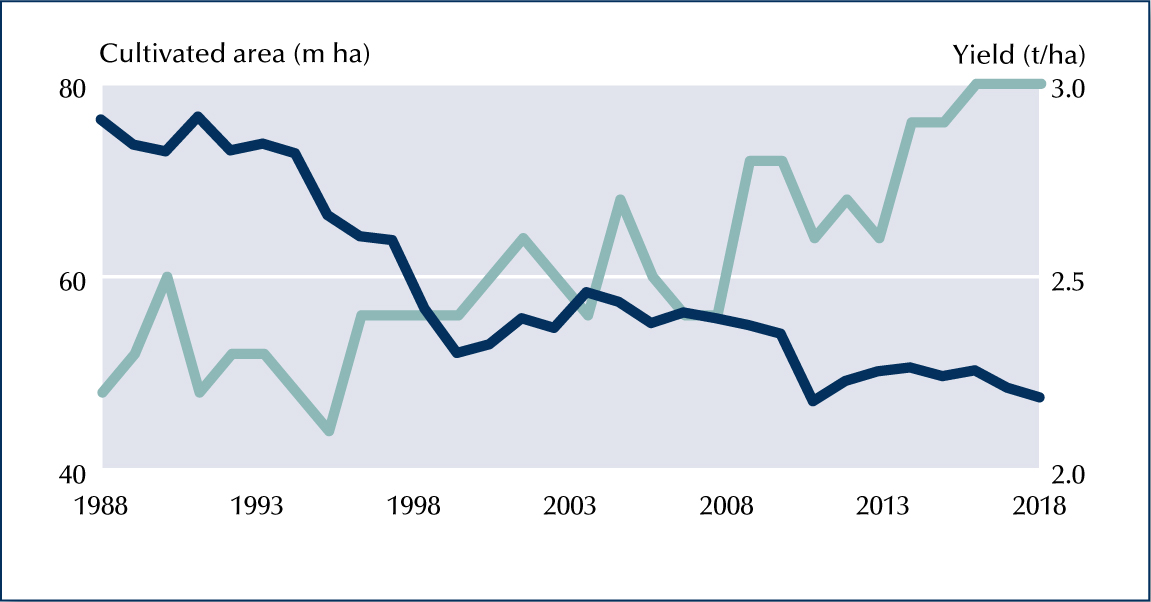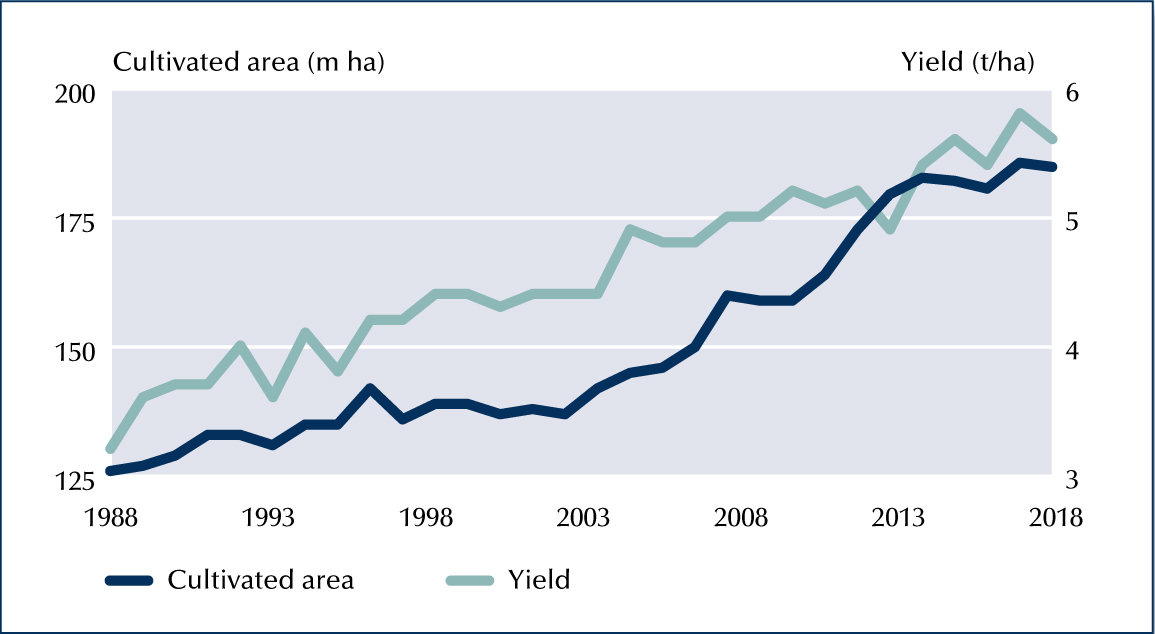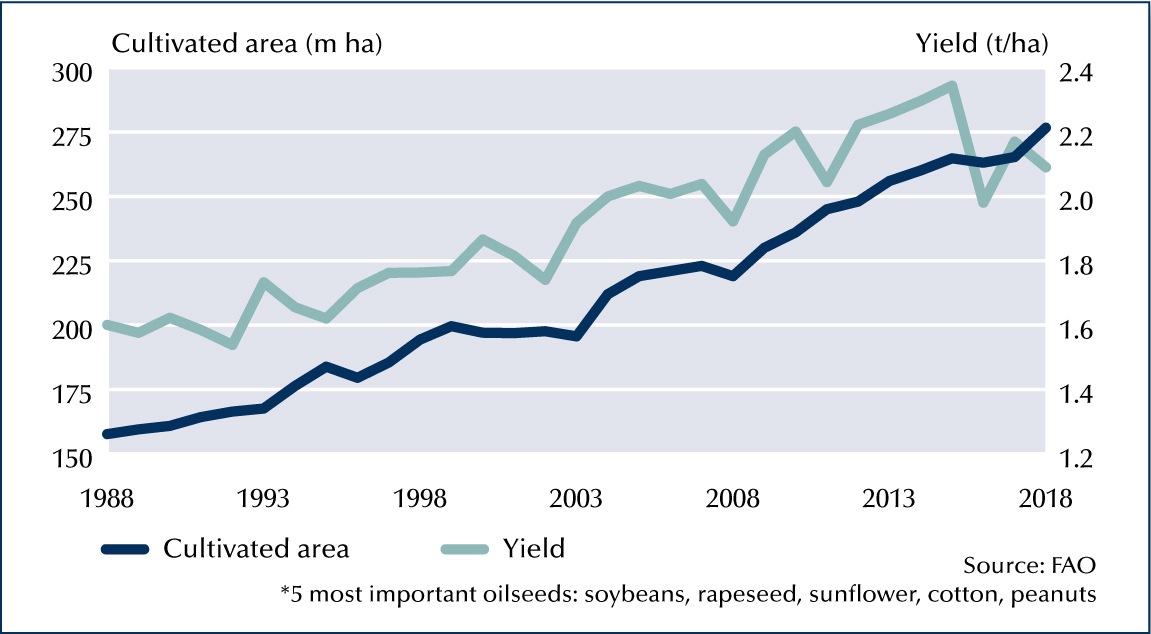Ways ahead for wheat
Harvest yields. The larger wheat harvests throughout the world are only the product of the crop’s increased yield capacities and not through expansion of growing area. This sort of situation increases harvest risks – but also the chances of higher prices. This applies even more so for barley.
By Christian Bickert
Around 100 million tonnes more wheat, approximately 250 m t more maize and 120 m t more soybeans: the worldwide grain and oilseed harvests have increased sharply over the past 30 years. Where have such increases come from?
Wheat
The global wheat growing area has remained more or less constant since the end of the 1980s. If one says 220 m ha, this cannot be very far off the mark. On individual years the growing area might have risen or dropped by 10 m ha more or less. But that represents just 5%, making no more change in total yields than a warm rain at the right time during growing, or the effect of a hard frost in the northern hemisphere.
Expansion of the global wheat harvest is based on continuously increasing yields. From a good 2.3 t/ha at the end of the 1980s, the average yield has moved up to 3.4 t/ha now. Main regions behind this development are East European lands as well as those in Canada and China. Above all in East Europe, the combination of improved seed, additional fertiliser, greatly improved machinery and technology and above all intensified crop husbandry know-how have all led to this success. On the other hand, yield increases have been less dramatic in the USA and in Europe. In West Europe, cropping intensity is waning. There, yield stabilisation is the most important aim of breeding progress.
Wheat growing area and yields
The global wheat growing area has remained more or less constant since the end of the 1980s. If one says 220 m ha, this cannot be very far off the mark. On individual years the growing area might have risen or dropped by 10 m ha more or less. But that represents just 5%, making no more change in total yields than a warm rain at the right time during growing, or the effect of a hard frost in the northern hemisphere.
Expansion of the global wheat harvest is based on continuously increasing yields. From a good 2.3 t/ha at the end of the 1980s, the average yield has moved up to 3.4 t/ha now. Main regions behind this development are East European lands as well as those in Canada and China. Above all in East Europe, the combination of improved seed, additional fertiliser, greatly improved machinery and technology and above all intensified crop husbandry know-how have all led to this success. On the other hand, yield increases have been less dramatic in the USA and in Europe. In West Europe, cropping intensity is waning. There, yield stabilisation is the most important aim of breeding progress.
Barley
Almost just as high as wheat have been growth rates of worldwide barley yields over the years, whereby growth has been less steady. In fact, main momentum in this respect has been in the last 10 years (in other words since the higher grain prices phase). In this period, yield growth for barley has actually been markedly greater than for wheat. But the barley yield increase is due only to a small extent to cultivation intensity or breeding advances. At least just as decisive has been the withdrawal of barley growing from locations with low yield potential. In structural terms, barley will remain weak in the coming years. This is because the growing areas are not getting any larger and yield increases through technical and breeding advances remain modest. Therefore the price gap between wheat and barley based on yearly averages could well narrow. That barley is more expensive than wheat, or at least sells at the same price as at present, will nevertheless be the exception. For high yield regions such as Germany, this represents opportunities.
Barley growing areas have suffered a complete breakdown. Growing areas worldwide have almost halved in the last three decades. The replacement of barley (above all through maize but partly, too, by oilseeds) has taken place mainly in areas where, as in Russia, the Ukraine and East Europe, 2 t/ha represented a good yield. In the high yield growing regions of West Europe or in Canada with averages of 4 to 5 t/ha, shrinkage in growing area is much less marked. In this situation the average yield therefore increases without any further effort.
Maize
Clear winner as far as growing area is concerned since the end of the 1980s has been maize. And above all since 2003 this crop’s growing area has nothing less than exploded, expanding by a good 60 m ha. This goes back to the substituting of maize for barley in the Ukraine and Russia, to the (in the meantime ended) subsidising of maize growing in China and to the clearing of new growing land in Brazil and Argentina.
Parallel to the expanding areas for maize growing, yield has also been increasing - and this not only, as with wheat, in locations of lower yield potential where a little extra intensity helps the crop catch up, but also where harvests were traditionally heavy. More than with all other types of grain, advances in breeding have been, and still are, substantial. Nowadays, the worldwide average of 5.5 t/ha means that almost double as much maize grain is being carted home compared with 30 years ago, and that represents a mighty expansion.
Oilseeds
It doesn’t matter whether for oil or for protein pulp – oilseeds have been consistently in short supply in the past years and therefore the prices, apart from a few phases, have remained consistently high. This has naturally led to very considerable expansion of growing areas. Worldwide cultivation of the five most important oilcrops (soybeans, rapeseed, sunflowers, cotton and peanuts) increased by 100 m ha since 1988, i.e. by 70 %. With that, oilseeds have the greatest expansion of all crops, a reflection of the demand.
For all the five major oilseeds yields have risen by 40% in 30 years (from 1.6 t/ha to 2.3 t/ha). The soya yield developed a little differently (+ 35% since 1988), which can also lie in the fact that a very large area of soybeans has been established on new land and, with that, on suboptimum locations or on regions that first of all have to be worked up towards full production potential. Overall, however, harvest yield growth of oilseeds definitely depends on expansion of total growing area.






